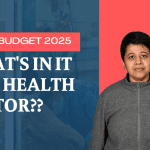Making health system push economic growth: a case of missed opportunity Premium


Making health system push economic growth: a case of missed opportunity Premium
To make our economy grow, we need to push private consumption. To increase private consumption, people need more disposable income. For that, one route is to reduce the money an ordinary person spends on basics such as health and education. The Union Budget 2025-26 seems to have missed this opportunity. We need to focus on ensuring higher uptake of public health facilities. A third-term government with stability and continuity can take higher risks to push for bolder programmes and structural changes. But the Budget does not seem to indicate this direction. It is business as usual.
The key department within the Health ministry, the Department of Health and Family Welfare (DoHFW), which runs most of the critical public health programmes, saw a meagre 11% increase in its annual Budget Estimates (BE) from last fiscal year’s (FY25) Revised Estimates (RE). This year’s increase has been the lowest in three years. When we compare what has been allocated in a given year versus what was fully spent by the department in the previous year, the limited financial envelop of the department becomes even more stark. We have data on actual spends by the DoHFW till 2023. In 2023, the actual spend was ₹80,292 crore and in 2024 the RE to the DoHFW was a mere 7.8% higher at ₹86,582 crore. Since 2021, a rise in allocations when compared with actual spends in the previous years has been between 6% and 8% only. This excludes the year 2022-23 when the money available to DoHFW fell by 7% from the actual spending the previous year in 2021-22.
Within health, the focus remains on the national level insurance programme- the Pradhan Mantri Jan Arogya Yojana (PMJAY), for which allocations have risen by 24% from last year’s RE. And a 41% higher allocation this year from actual usage in 2023, which is the latest data available. For the National Health Mission (NHM), the increase in allocations from 2024 (RE) to this year’s Budget is a meagre 3.4%. The urban component within NHM has increased allocation from last year (2024) Budget (RE) by a mere 4.3%. This is particularly worrying for NHM. It’s a national level programme covering rural and urban health. With slowing economic growth, its implications for jobs and wages, under financed and weak health system for rural and urban poor creates perfect conditions for a health crisis, and could further pull-down economic growth. What is most interesting about the NHM is that it is one of the government’s programmes that has been spending more than what has been estimated in that year every year since 2015, except in 2021- the pandemic year, when allocations were higher than the spends. The allocation is increased in the next year when compared with the actual spend in the previous one but the increase is a paltry amount at its best.
Insurance programmes increase the availability of hospital options by roping in private facilities. But by its nature, in an insurance-led health system, the focus remains on secondary and tertiary care and curative services. A public health system, on the other hand, provides primary care — basic illnesses, routine health check-ups, etc. and also preventive and proactive services which are not covered by insurance. Private hospitals can become options for eye surgery and with insurance, they become easily accessible to the poor but all other ailments need primary care, which isn’t in the ambit of insurance.
The Budget does not reveal numbers for primary care services, which it has been providing through the Health and Wellness Centres, but the NHM and NUHM estimates reveal that there haven’t been any meaningful rise in allocations.
Close to 50% of our health care is provided by the private sector, according to the most recent National Family Health Survey 5 data (2019-2021). At the primary care level, only 10% visit a government PHC in rural areas. In urban areas, this further reduces to 5%. But, there is immense pent up health demands, which insurance does not cover. Taking the example of urban primary care in parts of Rajasthan. When compared with hospitals, private clinics, etc. per day UPHC visits are very low, they exceed the capacities of many top class UPHCs. In places like Jaipur, Udaipur and Ajmer in Rajasthan, per day UPHC load goes up to 250 for many of the well-functioning, well-located accessible UPHCs. It appears that even though UPHCs are fulfilling a very small load of health services, they are providing a lot despite limited capacity.
But in many cases, the challenge is the lack of facilities. Karnataka, for example, has a 38% UPHC deficit. There are similar deficits of staff including specialists, Auxiliary Nurse-Midwifes, pharmacists, health programmes mangers nationwide. Uptake of facilities falls when staff is not available, or, if the time per visit is long.
While our out-of-pocket expense (OOPE) has fallen from 63% in 2014 to 39.4% in FY2021-22 as per the most recent available data provided in the National Health Accounts (NHA), it still remains high by global standards. According to a WHO’s global health expenditure database, India remains in the category of countries with the second highest range of OOPE in the world at 46% in 2022.
Low overall allocations to health when matched with a focus on insurance also means that we are really excluding the ‘middle classes’ – the ones whose consumption can fuel growth and the ones who need the extra spending capacity. But these are the classes who are not covered by the insurance programmes and rely on the public system to reduce health care expenses, particularly in urban India. And it’s this stratum, which will be much affected by the lukewarm Budget allocations to health.
As the year unfolds, the government will be well advised to revisit its health allocations and redirect its focus on the NHM. Within this, a strong focus on primary care, both for improving infrastructure and increasing staff hiring is fundamental to raising uptake and reducing time to care.
An economic growth led by a strong public health sector will be a sustained and rooted one, resistant to external shocks and responsive to new challenges. It’s time the Budget priorities align with this ideal.
(The writer is Fellow, Centre for Social and Economic Progress (CSEP). The views expressed are personal.)










